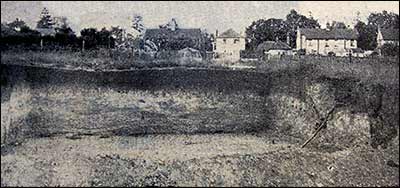|
|||
| The Rushden Echo and Argus, 3rd July 1953, transcribed by Gill Hollis |
|||
|
Centuries Added to Story of Rushden
|
|||
|
Discoveries belong to Roman era
|
|||
|
Several centuries are added to the known age of Rushden – and, for that matter, Higham Ferrers – as the result of the discovery last April of human remains on land between Spencer Road and Hayway.
It was in mid-April that workmen excavating on the site of Rushden’s new school for girls found a small cluster of brown bones about thirty inches below the surface. The bones were handed to the police and then, when their great age became apparent, passed into the care of Mr. A. Norman Groome, the Rushden solicitor and archaeologist. Shortly afterwards some small pieces of pottery and an old coin were found at the same spot. Mr. Groome sent all the finds to London for expert examination and has now received a report which indicates that there were permanent settlements in this neighbourhood during the Roman occupation. Expert View The story, as told by Mr. Groome, reveals that the expert consulted was Mr. W. F. Grimes, director of the London Museum, who is a leading authority on the subject. He states that a coin found on the site is a “third brass” of the Roman Emperor Victorinus, dated 268 – 270 A.D. The pieces of pottery show a degree of admixture. Two fragments are colour coated and late Roman, and a further group are also of Roman origin, one being a piece of a late white ware mortarium. The remainder of the pottery is what is called “native ware” and is of course, work which might belong to any date but, being wheel made, is certainly Beigic or later.
All the finds come from a level about two or three feet below the present surface of the field, and at this level in many places a layer of loose stones, rubbish, animal bones and odd pieces of pottery can be seen. It is thought that at the time the site was occupied this would represent the surface. Near the spot where the bones were unearthed are two pits about seven feet deep, which have certainly been dug at a much later date, and it may have been in the digging of these that the skeleton was disturbed. Under the black top soil is a layer of gravel, and below that blue clay, and it was probably to reach the water retained by this clay that the pits were dug. Without further evidence it can only be said that the people used the southern slope of this hillside during the latter part of the Roman occupation of Britain and that the skeleton probably belongs to the same period. New Lights It is known that there was a good-sized Roman town at Irchester and settlements at Stanwick, Raunds and other places along the Nene Valley. At the north end of Higham at least three Roman coins of about the year 300 A.D. have been dug up, and others have been found on the Irthlingborough side of the valley. On some maps a presumed Roman road is shown along the right bank of the Nene Valley from Irchester to Castor, where there was a thriving township with a well-known pottery industry. It has never previously been suspected that Rushden and Higham were permanently settled until the Anglo-Saxon invasions of the seventh century. It is known that these later settlers often avoided the earlier sites for superstitious reasons, and that it may be that the pleasant slope from the moors to the hilltop was once a small village where the cultivation of a few small fields provided a living for a few Romano-British natives and was later abandoned when the Romans left Britain or later when the Anglo-Saxon invaders arrived and chose another site. Local people tell of other skeletons having been found on the north side of Hayway and in the old sand pits, and it may well be that further links in the story will come to light. The pieces of pottery which have played the major part in dating the site are all rather unpromising material to look at but anyone finding any object on or near the site, however unromantic it may appear, will do local history good service by submitting it for expert inspection. |
|||
|
|||
|
|
|||
